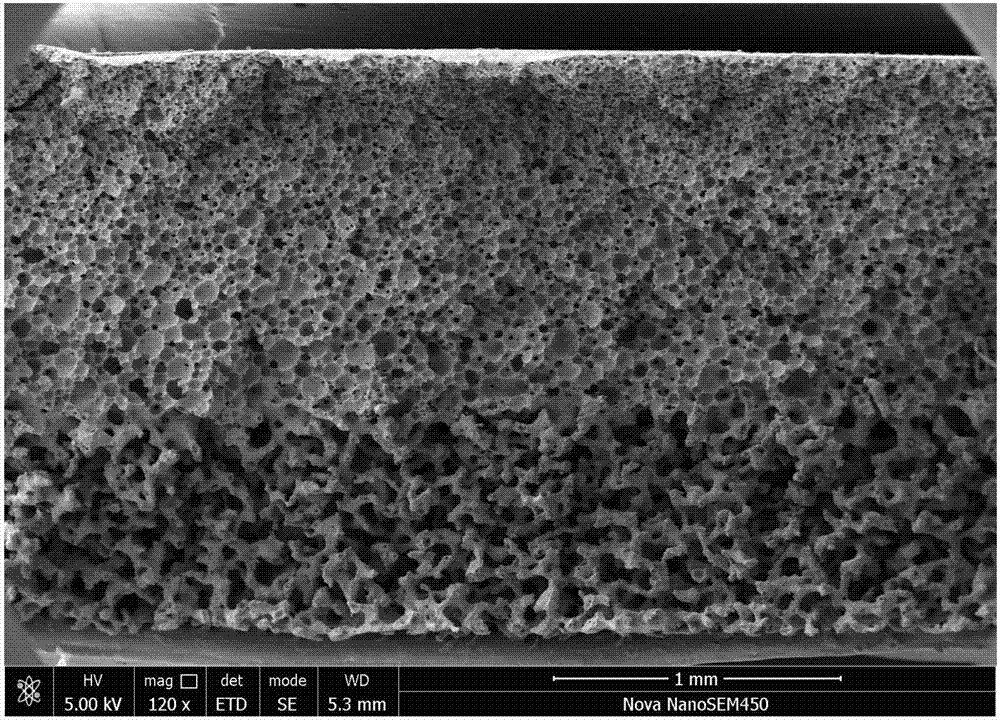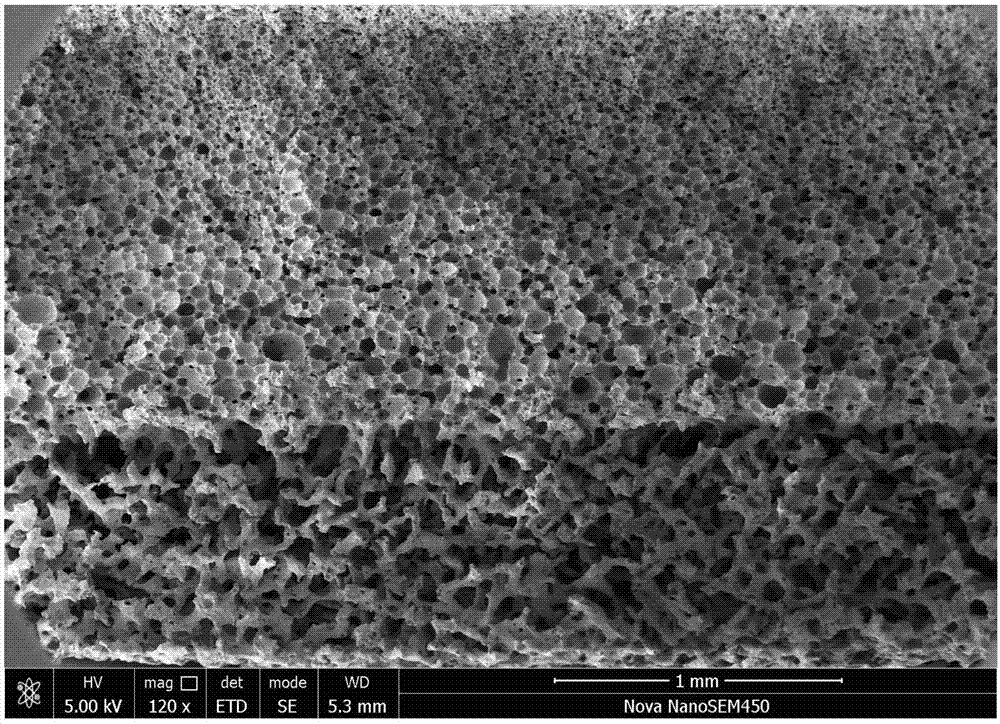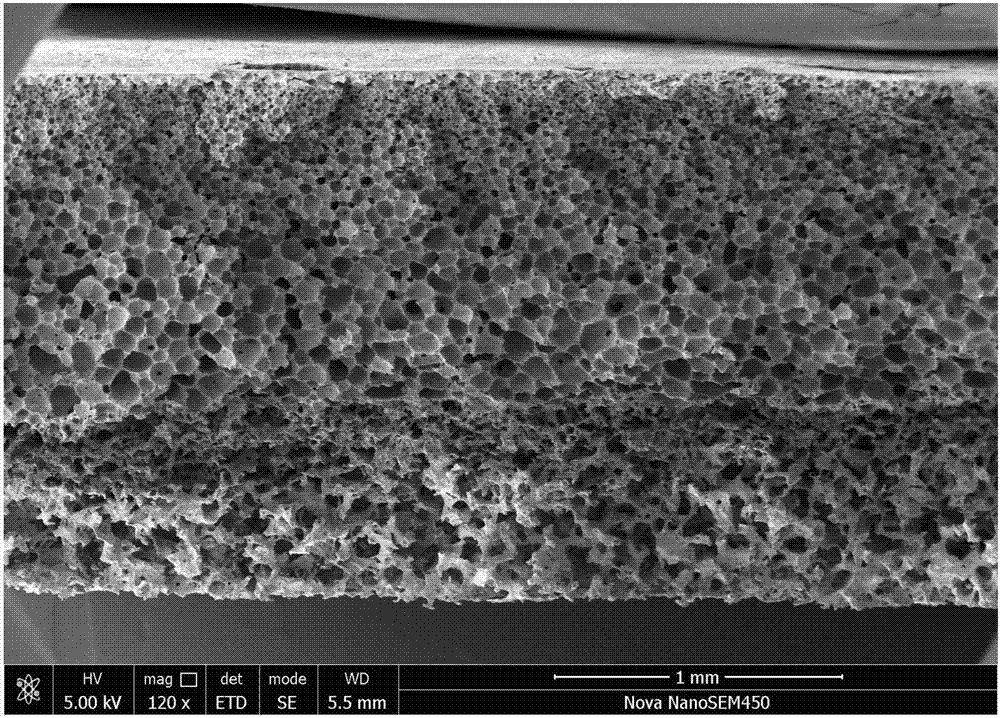Polyurethane porous thin film containing grapheme as well as preparation method and application thereof
A porous film and graphene technology, applied in medical science, prosthesis, etc., can solve the problems of increased risk of wound infection, limited drainage capacity, and can not be used for a long time, to prevent external bacterial infection, easy to control performance, good air permeability Effect
- Summary
- Abstract
- Description
- Claims
- Application Information
AI Technical Summary
Problems solved by technology
Method used
Image
Examples
Embodiment 1
[0040] Dissolve three parts of 25g medical grade polyurethane in 150mL of N,N-dimethylformamide at 60℃, and then add 50mL of graphite oxide to the concentration of 0.25mg / mL, 0.5mg / mL, 2.5mg / mL respectively. The alkene solution was stirred for 2 hours, 60 g of sodium citrate with a particle size of 75-150 μm was added, and the mixture was mechanically stirred for 1 hour. Degas the above solution at room temperature and a vacuum of 0.06 MPa for 20 minutes. Pour the defoamed suspension evenly into a polytetrafluoroethylene mold with a coating film thickness of 2 mm, and then put it in anhydrous ethanol at 25° C. for phase separation and solidify into a film. The cured porous membrane is washed in deionized water at 25°C, and the porogen is fully filtered out. The porous membrane from which the porogen is filtered out is placed in a blast oven at 40°C for drying to obtain a graphene-containing polyurethane porous membrane.
[0041] Structural characterization and performance testi...
Embodiment 2
[0055] Dissolve 25g of medical grade polyurethane in 150mL of N,N-dimethylformamide at 60°C, then add 50mL of 0.5mg / mL graphene oxide solution and stir for more than 2h. Degas the above solution at room temperature and a vacuum of 0.06 MPa for 20 minutes. Pour the degassed solution evenly into a polytetrafluoroethylene mold with a coating film thickness of 1 mm, and then put it in anhydrous ethanol at 25°C for phase separation and solidify into a film. The cured polyurethane porous membrane was washed in deionized water at 25°C. The porous film was dried in a 40°C blast oven to obtain a graphene-containing polyurethane porous film.
Embodiment 3
[0057] Dissolve three parts of 25g medical grade polyurethane in 150mL N,N-dimethylformamide at 60℃, and then add 50mL graphene oxide solution with concentration of 5mg / mL, 10mg / mL and 25mg / mL respectively. Stir for 2h, add 60g of sodium citrate with a particle size of 75-150μm, and mechanically stir for 1h. Degas the above solution at room temperature and a vacuum of 0.06 MPa for 20 minutes. Pour the defoamed suspension evenly into a polytetrafluoroethylene mold with a coating film thickness of 2 mm, and then put it in anhydrous ethanol at 25° C. for phase separation and solidify into a film. The cured porous membrane is washed in deionized water at 25°C, and the porogen is fully filtered out. The porous membrane from which the porogen is filtered out is placed in a blast oven at 40°C for drying to obtain a graphene-containing polyurethane porous membrane.
PUM
| Property | Measurement | Unit |
|---|---|---|
| thickness | aaaaa | aaaaa |
| particle diameter | aaaaa | aaaaa |
| tensile strength at break | aaaaa | aaaaa |
Abstract
Description
Claims
Application Information
 Login to View More
Login to View More - R&D
- Intellectual Property
- Life Sciences
- Materials
- Tech Scout
- Unparalleled Data Quality
- Higher Quality Content
- 60% Fewer Hallucinations
Browse by: Latest US Patents, China's latest patents, Technical Efficacy Thesaurus, Application Domain, Technology Topic, Popular Technical Reports.
© 2025 PatSnap. All rights reserved.Legal|Privacy policy|Modern Slavery Act Transparency Statement|Sitemap|About US| Contact US: help@patsnap.com



